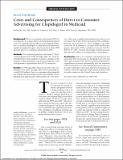| dc.contributor.author | Law, Michael Robert | |
| dc.contributor.author | Soumerai, Stephen Bertram | |
| dc.contributor.author | Adams, Alyce S. | |
| dc.contributor.author | Majumdar, Sumit R. | |
| dc.date.accessioned | 2017-05-16T19:16:01Z | |
| dc.date.issued | 2009 | |
| dc.identifier.citation | Law, Michael R. 2009. “Costs and Consequences of Direct-to-Consumer Advertising for Clopidogrel in Medicaid.” Archives of Internal Medicine 169 (21) (November 23): 1969. doi:10.1001/archinternmed.2009.320. | en_US |
| dc.identifier.issn | 0003-9926 | en_US |
| dc.identifier.uri | http://nrs.harvard.edu/urn-3:HUL.InstRepos:32696181 | |
| dc.description.abstract | Background Direct-to-consumer advertising (DTCA) is assumed to be a major driver of rising pharmaceutical costs. Yet, research on how it affects costs is limited. Therefore, we studied clopidogrel, a commonly used and heavily marketed antiplatelet agent, which was first sold in 1998 and first direct-to-consumer advertised in 2001.
Methods We examined pharmacy data from 27 Medicaid programs from 1999 through 2005. We used interrupted time series analysis to analyze changes in the number of units dispensed, cost per unit dispensed, and total pharmacy expenditures after DTCA initiation.
Results In 1999 and 2000, there was no DTCA for clopidogrel; from 2001 through 2005, DTCA spending exceeded $350 million. Direct-to-consumer advertising did not change the preexisting trend in the number of clopidogrel units dispensed per 1000 enrollees (P = .10). However, there was a sudden and sustained increase in cost per unit of $0.40 after DTCA initiation (95% confidence interval, $0.31-$0.49; P < .001), leading to an additional $40.58 of pharmacy costs per 1000 enrollees per quarter thereafter (95% confidence interval, $22.61-$58.56; P < .001). Overall, this change resulted in an additional $207 million in total pharmacy expenditures.
Conclusions Direct-to-consumer advertising was not associated with an increase in clopidogrel use over and above preexisting trends. However, Medicaid pharmacy expenditures increased substantially after the initiation of DTCA because of a concomitant increase in the cost per unit. If drug price increases after DTCA initiation are common, there are important implications for payers and for policy makers in the United States and elsewhere. | en_US |
| dc.language.iso | en_US | en_US |
| dc.publisher | American Medical Association (AMA) | en_US |
| dc.relation.isversionof | doi:10.1001/archinternmed.2009.320 | en_US |
| dash.license | LAA | |
| dc.title | Costs and Consequences of Direct-to-Consumer Advertising for Clopidogrel in Medicaid | en_US |
| dc.type | Journal Article | en_US |
| dc.description.version | Version of Record | en_US |
| dc.relation.journal | Archives of Internal Medicine | en_US |
| dash.depositing.author | Soumerai, Stephen Bertram | |
| dc.date.available | 2017-05-16T19:16:01Z | |
| dc.identifier.doi | 10.1001/archinternmed.2009.320 | * |
| dash.authorsordered | false | |
| dash.contributor.affiliated | Law, Michael Robert | |
| dash.contributor.affiliated | Soumerai, Stephen | |


